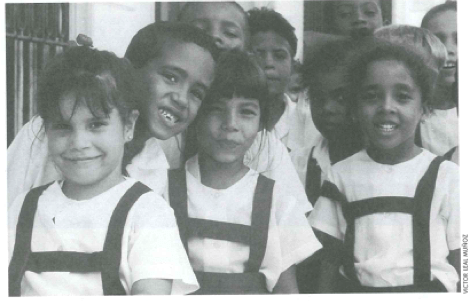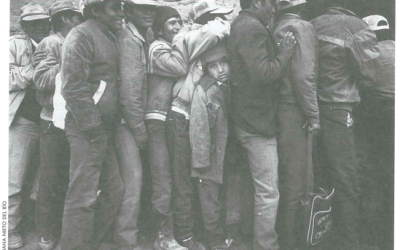Art and Economy
Focus on Cuba

Young pioneers look to the future.
As Cuba comes to terms with a dollarized economy and increasing numbers of foreign tourists, the island finds itself in a controversy that is as much about art as it is about economics. The question of artistic existence and survival has become a pressing one, and ideology has had to form a pact with what cultural discourse elsewhere might call high art. In this climate, artistic integrity is pitted against commercialization, originality against prescription and – in a curious turnaround, considering the “Revolutionary” slant of literature in the past three decades – aesthetics against politics.
Postmodernism, understood as “anything goes”, is perceived as a threat to both the unity of the Revolution and the respectability of art. The literary establishment, like the political one, is worried about preserving its difference in a world where globalization threatens Cuban autonomy. Creativity is feared to be in peril as cultural production responds to the demands of new, mainly foreign markets. New questions are being asked: who are artists producing for what drives them, in the shift from an isolated economy to one in which there is increasing freedom of exchange with other countries? how do these exchanges affect their work what is art in the time of globalization, and where is culture in a world of commodities?
To a degree, the issue of art and economics is one affecting all of Latin America as economies move from state-subsidized and centralized systems to free-market ones. The debate is also a vital one in Eastern Europe, where some artists and writers find themselves groping in market economies without state support and others previously excluded from the system find themselves without the aura of dissidence. The Cuban dilemma is unique because its politics set it apart: it has a system which, with one hand, has invested heavily in education and cultural institutions, yet, with the other, has taken away, or at least restricted, artistic freedom. It is symptomatic, however, because yet again a Latin American country sees itself battling against the forces of imperialism and of a majority culture which seeks to consume and redefine it according to its own tastes and desires.
Since the Soviet Union collapsed and withdrew its support, Western cultural capital has circulated more freely in Cuba. The legalization of the dollar in 1993, during the Special Period of severe hardship, was an economic necessity rather than an acceptance of capitalism, but it nevertheless accelerated interaction with capitalist economies. This encouraged cultural change, too. Restrictions governing cultural and educational exchange between Cuban and the US have recently been relaxed but, even before these official stimuli, contact between individuals affected artistic production.
Tourism, an economic phenomenon that brings increasing numbers of foreigners to Cuba every year, has spawned a series of sub-industries: around medicine and ecology, vintage cars and tobacco, spiritualism and sex and, inevitably, music, art and literature. Each of these areas has its own marketplace, its own chains of supply and demand as well as players from inside and outside the island. Plastic arts were the first to take advantage of foreign investment on a large scale, and consequently more people have turned to art as a means of making money. Painters mass produce scenes of Old Havana and pristine 1950’s cars under palm trees at Santa María beach although, to be fair, as in most professions, they try to find some time to respond to their own and not the market’s demands.
The increasing international popularity of salsa has an effect on national production. The musical profession attracts more and more people, and every hotel bar in old Havana plays tracks from Buena Vista Social Club album. Another apparent response to the market is the fate of “santería,” a previously somewhat suspect syncretic religion has become a profit-making venture thanks to tourists interest in it. Now, the government sponsors events that attract a dollar-paying crowd to these formerly more private rituals. The fact that Buena Vista Social Club won a Grammy and that Afro-Cuban religious ceremonies have become a crowd-puller does not, however, have to be seen as a sell-out to the capitalist world. These art forms continue to develop on their own, away from the tourist areas — where there are no foreign visitors there is little “Chan Chan” and santería is less of a spectacle. Those who may appear simply to be sell-outs merely may be adopting provisionary sell-out stances, doing what is demanded of them insofar as it makes it easier to do what they want. Instead of understanding art purely as commerce, music as Musak, santería as impotent, or for that matter, literature as pornography, why not look toward the spaces in-between content and presentation, communities of interpreters, and versions of performances. Take, for example, recent Cuban fiction. Until 1989, fiction was printed and edited in Cuba, and showed a preference for Revolutionary themes. The industry, though, was hit directly by the post-Soviet paper shortage and forced to consider costs for the first time. Thanks to material support from Eastern Bloc countries, editors had previously been able to focus on the literary (and ideological) merits of works. Economic change resulted in a disparity between creative and material output and fewer and less lavish works, such as the “plaquette” stories printed during the hardest years on recycled paper and card. The situation eased during the past five years because, with more money at its disposal, the Ministry of Culture can fund more generously. The influx of foreigners to the island has had more direct effects, though. New markets have emerged, at home and abroad: the “mercado de frontera” books sold in dollars to visitors to Cuba accounts for a significant percentage of sales, and sales outside the island are increasing. Publishers have entered into joint ventures with foreign editorials similar to those with Spain, Mexico, Canada and elsewhere for hotels that have sprung up along the coastline. Arguably they, too, have embarked on a construction project: the reconstruction, or reorientation, of Cuban literature. Literature is no longer addressed solely, or even principally, to Cuban readers. What the foreign publisher wants to read and what will sell abroad have become a consideration – the main one, say some critics.
The summer of 1999 slowly passes and the Special Period has not been officially declared over, although the hardest years seem to have passed. However, survival is still a struggle and entails different forms of hustling: these have become a standard theme of Cuban fiction, at their harshest in the novels of exiled writer Zoé Valdés but present, too, in younger writers resident on the island. The novísimo group of writers born after 1959, championed by the late Havana University professor Salvador Redonet, consider these themes of social deprivation and others that previous decades swept under the carpet. Homosexuality, for example, was a taboo that once caused severe retribution as exposed in the documentary Mauvaise Conduite (1984) (Improper Conduct;) but the young writers – encouraged, perhaps, by the institutional acceptance of Tomás Gutierrez Alea’s and Juan Carlos Tabío’s 1993 film Fresa y Chocolate (Strawberry and Chocolate)- have made it commonplace. Erotic fiction is making a comeback in an environment which permits all but the most overtly political themes, and young writers are resorting to it more than ever.
This contrasts with the 70s and 80s when all writings challenging revolutionary paradigms were considered subversive. After Heberto Padilla, the 1968 UNEAC poetry prize winner was imprisoned for betrayal, then forced to apologize for his own actions and betray his friends, many intellectuals abroad publicly distanced themselves from the Revolution. Foreign cultural imports were restricted for years even though the Revolution embraced the African, European, Asiatic and indigenous as foundational elements to the island’s history and identity. Contact with the outside world was mediated through a particular ideological framework, embracing the Soviet Union and other sites of Socialist fervor. Work that emerged from the period was somewhat uniform in nature in its focus on the state of Cuba and the revolution, and non-conformity was a charge that sent many, like Reinaldo Arenas, into rehabilitation.
Themes which were once taboo recur today with such frequency that they are perceived as a sell-out, aimed at publishers, mainly from Spain and elsewhere in Western Europe, who set down a crude prescription: sex, salsa, starvation and political repression. Writers response to these demands which is first and foremost a response to the economic situation is being met with resistance by the cultural establishment, by the critics who run the country’s institutions and fill the columns of its literary journals. Just as the Boom novels of the 1960s have been re-evaluated as an economic phenomenon, with Europe and the US avid for tales of a surreal and primitive Latin America, the relation between writer and market in Cuba is coming under scrutiny. Zoé Valdés, and those on the island who have not entirely ignored her example, are criticized for betraying creative standards. El Caimán Barbudo, the cultural newspaper linked to the Union of Young Communists (UJC) is in the throes of a debate about the implications of writing for an international market, of sensationalizing oneself and one’s people.
Unity and seamlessness are still the mission of the political establishment and the literary old guard, even as they admit the inevitability – the necessity – of foreign cultural invasion. They struggle to maintain the image, at all costs: colonial houses on the Prado, the historic walkway from the sea to the Parque Central, are renovated in facade only, leaving the homes behind them in ruins; carnival – always controlled abandon – is more visibly reined in than ever, with barriers keeping the crowds from the parade and an early curfew for the main festivities. Yet both the new Prado and the more lavishly festive areas of carnival – inflatable Havana Club rum bottles, well-stocked dollar-only bars – are to an extent an attempt to accommodate tourists, for cultural purism cannot but bend to economic necessity. The question is: can the writers, the artists and the system they’re working in maintain a balance? Can they use capitalism to their advantage, participate in globalization of culture to the extent that it allows entry to markets, but maintain a sense of integrity (for artists) and of autonomy (for the Revolution)? Can they buy in without selling out? It’s a race against time; a race, in fact, against economics.
Fall 1999
Esther Whitfield is a graduate student in Romance Languages & Literatures at Harvard. She studied in Cuba as an undergraduate in 1992 and has returned several times since. She is writing her dissertation on language and economics in contemporary Cuban narrative published in Cuba, Spain and the United States.
Jacqueline Loss is a graduate student in Comparative Literature at the University of Texas at Austin. Her dissertation reevaluates different versions of cosmopolitanism in the context of late nineteenth and twentieth-century Spanish American literature, with a focus on Cuban narrative.
Related Articles
Poverty or Potential?
Teresa stops me three blocks from Nueva Imperial’s main plaza on a quiet Wednesday morning, eager to chat. She is wearing a light blue sweater and a matching blue headband glowing slightly against her dark black hair.
Infections and Inequalities
I read Paul Farmer’s book while on a short visit to Venezuela, and found that setting, at this historical moment in time, particularly pertinent and highly conducive to the arguments Farmer…
Proclaiming the Jubilee
Carmen Rodríguez heads the Charismatic Movement in a sprawling shantytown parish south of Lima, Peru. She and other lay leaders of the Lurín Diocese have been preparing for the…



